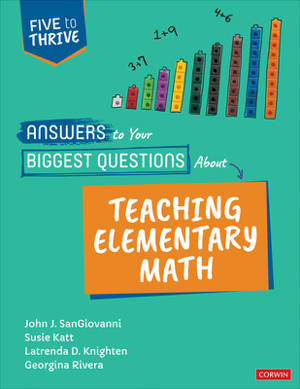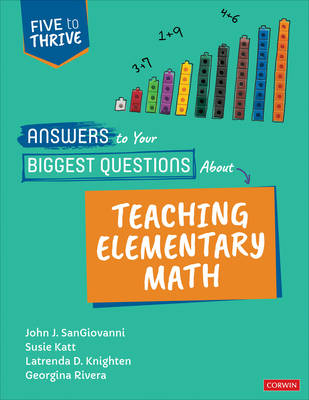
- Afhalen na 1 uur in een winkel met voorraad
- Gratis thuislevering in België vanaf € 30
- Ruim aanbod met 7 miljoen producten
- Afhalen na 1 uur in een winkel met voorraad
- Gratis thuislevering in België vanaf € 30
- Ruim aanbod met 7 miljoen producten
Zoeken
Answers to Your Biggest Questions about Teaching Elementary Math
Five to Thrive [Series]
John J Sangiovanni, Susie Katt, Latrenda Duretta Knighten, Georgina Rivera
€ 36,45
+ 72 punten
Omschrijving
Your guide to grow and learn as a math teacher!
Let's face it, teaching elementary math can be hard. So much about how we teach math today may look and feel different from how we learned it. Today, we recognize placing the student at the center of their learning increases engagement, motivation, and academic achievement soars. Teaching math in a student-centered way changes the role of the teacher from one who traditionally "delivers knowledge" to one who fosters thinking. Most importantly, we must ensure our practice gives each and every student the opportunity to learn, grow, and achieve at high levels, while providing opportunities to develop their agency and authority in the classroom which results in a positive math identity.
Whether you are a brand new teacher or a veteran, if you find teaching math to be quite the challenge, this is the guide you want by your side. Designed for just-in-time learning and support, this practical resource gives you brief, actionable answers to your most pressing questions about teaching elementary math. Written by four experienced math educators representing diverse experiences, these authors offer the practical advice they wish they received years ago, from lessons they′ve learned over decades of practice, research, coaching, and through collaborating with teams, teachers and colleagues--especially new teachers--every day.
Questions and answers are organized into five areas of effort that will help you most thrive in your elementary math classroom:
1. How do I build a positive math community?
2. How do I structure, organize, and manage my math class?
3. How do I engage my students in math?
4. How do I help my students talk about math?
5. How do I know what my students know and move them forward?
Woven throughout, you′ll find helpful sidebar notes on fostering identity and agency; access and equity; teaching in different settings; and invaluable resources for deeper learning. The final question--Where do I go from here?-- offers guidance for growing your practice over time. Strive to become the best math educator you can be; your students are counting on it! What will be your first step on the journey?
Let's face it, teaching elementary math can be hard. So much about how we teach math today may look and feel different from how we learned it. Today, we recognize placing the student at the center of their learning increases engagement, motivation, and academic achievement soars. Teaching math in a student-centered way changes the role of the teacher from one who traditionally "delivers knowledge" to one who fosters thinking. Most importantly, we must ensure our practice gives each and every student the opportunity to learn, grow, and achieve at high levels, while providing opportunities to develop their agency and authority in the classroom which results in a positive math identity.
Whether you are a brand new teacher or a veteran, if you find teaching math to be quite the challenge, this is the guide you want by your side. Designed for just-in-time learning and support, this practical resource gives you brief, actionable answers to your most pressing questions about teaching elementary math. Written by four experienced math educators representing diverse experiences, these authors offer the practical advice they wish they received years ago, from lessons they′ve learned over decades of practice, research, coaching, and through collaborating with teams, teachers and colleagues--especially new teachers--every day.
Questions and answers are organized into five areas of effort that will help you most thrive in your elementary math classroom:
1. How do I build a positive math community?
2. How do I structure, organize, and manage my math class?
3. How do I engage my students in math?
4. How do I help my students talk about math?
5. How do I know what my students know and move them forward?
Woven throughout, you′ll find helpful sidebar notes on fostering identity and agency; access and equity; teaching in different settings; and invaluable resources for deeper learning. The final question--Where do I go from here?-- offers guidance for growing your practice over time. Strive to become the best math educator you can be; your students are counting on it! What will be your first step on the journey?
Specificaties
Betrokkenen
- Auteur(s):
- Uitgeverij:
Inhoud
- Aantal bladzijden:
- 232
- Taal:
- Engels
- Reeks:
Eigenschappen
- Productcode (EAN):
- 9781071857717
- Verschijningsdatum:
- 12/10/2021
- Uitvoering:
- Paperback
- Formaat:
- Trade paperback (VS)
- Afmetingen:
- 214 mm x 274 mm
- Gewicht:
- 639 g

Alleen bij Standaard Boekhandel
+ 72 punten op je klantenkaart van Standaard Boekhandel
Beoordelingen
We publiceren alleen reviews die voldoen aan de voorwaarden voor reviews. Bekijk onze voorwaarden voor reviews.











